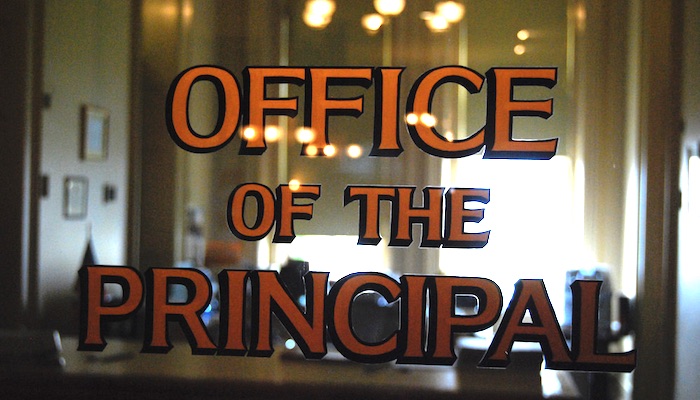
FEWER SUSPENSIONS?: Education Committee members at the Vermont Statehouse are being urged to implement policies that push schools to reduce suspensions and expulsions, especially for nonviolent incidents.
On Wednesday, lawmakers in the House Education Committee heard from two co-directors of the University of Vermont Building Effective Supports for Teaching project, who said schools should substantially reduce suspensions and expulsions as a disciplinary action.
Amy Wheeler-Sutton, one of the co-directors, spoke about Act 35, which was introduced in 2021 and relates to the “task force on equitable and inclusive school environments.”
In addition to creating a task force, the act required that a report be submitted to the Legislature annually beginning in 2025 to analyze the outcomes of disciplinary policies — and to limit suspensions and expulsions.

Amy Wheeler-Sutton is project co-director of Building Effective Supports for Teaching at the University of Vermont.
“It’s been really challenging for schools right now. They are trying to balance out the need to address these high-level individualized behaviors and safety concerns while also maintaining the safety and traditions of the other students in the classroom,” Wheeler-Sutton said.
She said due to the ongoing labor shortage need in education, her group recommends legislation that produces support rather than new mandates.
“Our hope is that any legislative action would take the form of additional support, strengthening of existing initiatives that are in place, rather than imposing or mandating anything new for schools at this time,” Wheeler-Sutton said.
One reason the group recommends limiting expulsions is the potential for kids to get more time and access to drugs.
“The challenge with drug and alcohol abuse is that if students have difficulty in that area, sending them home with minimal supervision is probably just going to increase their access to drugs and alcohol,” she said.
She added that under the status quo in Vermont, most suspensions do not involve acts of violence. Examples of behavior that should not result in getting removed from school, Wheeler-Sutton said, include skipping class or cursing at a teacher.
“Most of the suspensions that we are seeing are not due to some violent act,” she said. “… They are primarily disorderly conduct or school conduct violations.”
Another reason given for potentially reducing strong disciplinary action is the potential for social inequalities. However, Wheeler-Sutton admitted that current data isn’t clear bias exists in exclusionary disciplinary actions.
“The way that the data was collected in Act 45 didn’t actually get to a place where we were able to say that certain groups were over-represented in the data,” she said. “So we weren’t able to say that students of color in Vermont were disproportionately affected by this, or students with disabilities were disproportionately affected by this.”
Cassandra Townshend, the other co-director for the University of Vermont Building Effective Supports for Teaching Project, argued that students should remain in school as much as possible.
“As you know, Vermont is not alone in struggling with tricky students with behaviors and also the reactive response of suspension and exclusionary disciplinary practices,” she said. “What we know, and what we know nationally, is that when we exclude students from the learning environment, they are not in the learning environment to receive all of the fabulous stuff that we want them to learn about.”
Townshend suggested that minority groups — such as those with disabilities — may be getting sent home more often.
“There is significant disproportionalities in students being expelled and suspended from school,” she said. “Students who are, or identify as, having a learning disability … as well as our students of color.”
About 5% of students across the nation experience suspension. She suggested that at independent schools, there are cases where students aren’t accepted due to behavioral concerns.
“In some of our private child care centers, often times students are not even being accepted into the program due to behavioral and social, emotional concerns,” Townshendsaid.
The buzzword “equity” — the notion that outcomes for individuals and groups should always be equal — was mentioned as goal for reforming discipline in Vermont’s schools.
“We are hoping, too, that this report obviously is eye-opening ,and that you will really take the time to think about how are we putting policy practices in place that are creating equitable disciplinary practices,” Townshend said.
The hourlong meeting of the House Committee on Education can be viewed online here.
Michael Bielawski is a reporter for True North. Send him news tips at bielawski82@yahoo.com and follow him on Twitter @TrueNorthMikeB.



One problem is that demanding a high level of personal and parental responsibility and promoting the concept of the 2-parent nuclear family is denounced by some race-baiters as racist and culturally skewed.
It’s not just race though. Failed socialist welfare policies, misdirected feminism and some forms of LGBT activism over the last 50 years have promoted single parenthood and absenteeism of the father-figure and we are now reaping the result in the form of screwed up kids. Look at the statistics of students being suspended or otherwise disciplined and you will predominantly see kids who have grown up without a father and the essential chemistry of a functional two-parent, nuclear family.
Meanwhile all bfa fairfax has suspended all community members from attending varsity basketball games, even parents of players.
This was started by the Kenyan implant obama who tied school funding to letting his kids (black youth with criminal tendencies) off the hook when causing trouble in school. It will work out much the same as letting real criminals off the hook for their crimes, which results in more crime. When there is no punishment for wrong doing there will only be unfettered wrong doing. It’s idiot leftist logic which isn’t logical at all. Stupid is as Stupid does.
No, Mr. Bean. This started long before Obama became President. Folks like Horace Mann and Henry Bernard (white men) initiated the public education concept. And folks like Lyndon Johnson (a white President) perpetuated the soft bigotry of ‘affirmative action’. And some of the best thoughts on what public education has become, and what should change, have come from folks like Thomas Sowell, John McWhorter, Carol Swain, Ben Carson, and many other black people that don’t have ‘criminal tendencies’ – as if criminality was mutually exclusive to one’s race in the first place. I think a little introspection is in order for you, sir.
Did any of those you listed withhold federal dollars to schools unless they overlooked trouble makers disrupting classes? No I don’t think so, you take my disgust with obama who was a failure of epic proportions to mean I have a raciest attitude which I don’t. I have nothing but respect for blacks that deserve my respect. I judge people by their actions and convictions rather then the color of their skin.. obama didn’t have helping white criminal kids in mind when he did that I can assure you.
Mr. Dean: I respect that you are ‘walking back’ your previous statement.
Enough said.
This is all policy driven. The way our welfare system is structured, it encourages people with no parenting skills to have as many kids as possible. Throw in dysfunctional households, massive substance abuse and mental illness and this is what you get.
Bureaucrats and elected officials had no aversion to expelling moral absolutes provided us from the Bible. Harvard, Princeton and Yale started out as religious schools, a far cry from what they resemble today. Liberal Progressive Socialist Democrats love turning this into a race issue, with an element of truth associated with it. This anti-expulsion business started in urban areas that have a higher density of African-Americans. The data clearly reveals correlation of single parent families, which we overwhelmingly see in the black community, to expulsions. To avoid playing the race card Amy Wheeler-Sutton might look to Vermont Law makers, who legalized drug abuse. Without the threat of consequences, there will be chaos. Our ‘leaders’ send THEIR kids to private schools. They WANT public schools to fail so their kids get the best schools and the best jobs.
23 years ago we were warned, see below:
https://www.city-journal.org/html/who-killed-school-discipline-11749.html
Our ‘leaders’ send THEIR kids to private schools…
Shouldn’t everyone have that option? … to choose their own poison.
Then, at least, we could spend less time pointing our fingers at the ‘other guys’, whoever we think they are.
Corporal punishment should be allowed when other methods to control and correct inappropriate behavior fail.
Re: “It’s been really challenging for schools right now. They are trying to balance out the need to address these high-level individualized behaviors and safety concerns while also maintaining the safety and traditions of the other students in the classroom,” Wheeler-Sutton said.
Bingo. Balancing needs (i.e., ‘equity’ or one-size-fits-all) never works. Never has. Never will.
Again, the corrective governance need only be the enabling of School Choice tuition vouchers, letting parents choose the school they believe best meets the needs of their children. Some schools will have lenient ‘resource rooms’. Others will suspend or expel those misbehaving. Others may prosecute offenders in a court of law. Or any of the myriad other options available in the handling of individual behavior.
Then we get to choose what works and what doesn’t, as only a free market can provide.
Again, it really is just that simple. Provide School Choice Tuition vouchers for all parents and let them make their own decisions. No politicking. No debating.
HOw can this issue be up to the authority of the Statehouse?
Isn’t this something that the Superintendents have the right over?
Help us to understand , please.
Mr. Frye:
Public School governance is extremely convoluted, which is why is dysfunctional. Assigning responsibility to any group or individual is virtually impossible… by design.
First, there is the ‘Education Clause’ in the Vermont Constitution authorizing the establishment of public education funding. The VT Constitution also includes the ‘Common Benefits Clause’ establishing ‘equal opportunity’. Note that the Constitution does not establish ‘equal outcome’. One of the best places to read about the establishment of Vermont’s education governance is the VT Supreme Court decision on Brigham vs. State of Vermont.
Second, we have Title 16 of Vermont Statutes Annotated. These statutes are managed by the legislature.
Third, Title 16 authorizes all aspects of governance and a whole slew of ‘councils’ and ‘commissions’, including The Agency of Education, the State Board of Education, Supervisory Unions, School Boards and School Board policies that set disciplinary standards for local boards to follow.
Fourth, there is the wild card of Federal regulations that occur when federal funds are used in various programs, not to mention the federally mandated Individuals with Disabilities Education Act (IDEA) that has its fingers in almost every aspect of public education, including disciplinary regulations.
And then there are the NGO special interest groups, including but not limited to The VT School Board Association, Superintendent’s Association, Principal’s Association, and the gorilla in the room – the Teacher’s Union (VTNEA).
One way to put this in perspective is to consider the number of people employed by Vermont’s public school system. As I reported earlier, there are approximately 75,500 people employed, from the VT AOE to Superintendents to teachers and paraeducators to bus drivers and consultants. This group is approximately equal to the number of students enrolled in Vermont’s public schools.
Next question…?